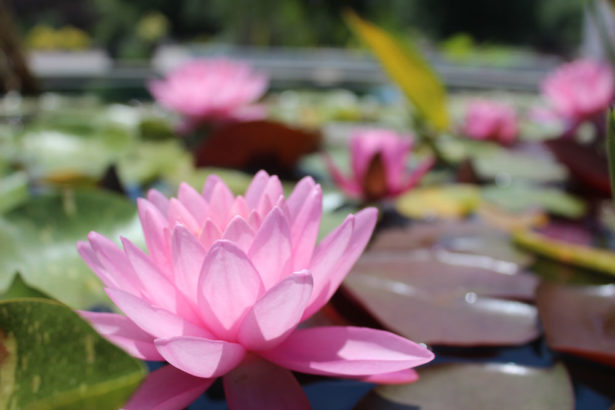Three locations, one state botanical garden
By Patricia McDaniels
Close your eyes and let your mind rest with visions of lush green lawns hidden behind the shade of tall trees. Imagine mounds of fragrant, flashy blooms and quiet retreats in sheltered gazebos beside gurgling fountains and koi-filled ponds. Converting that dreamscape into today’s UT Gardens has been a labor of love for the last 30 years.
Faculty, students, staff, friends and many generous benefactors have all contributed to the vision that now touches communities in all three grand divisions of the state. More than 100,000 have visited the UT Gardens in just the past year, and, if you’ll pardon the pun, that number and the gardens themselves continue to grow.
In April, after nearly eight years and countless hours of planning and planting on the part of the Cumberland County Master Gardeners, the UT Gardens welcomed the Plateau Discovery Gardens at the UT Plateau AgResearch and Education Center in Crossville, Tenn., as its third site. That collection of gardens joined the original UT Gardens, Knoxville, and the UT Gardens, Jackson, Tenn., and altogether the three sites make up the statewide UT Gardens system. That same month the state designated the UT Gardens as the official botanical garden for Tennessee.
Like entwined vines, the gardens form one state botanical garden stretched across three sites, with tentative plans to add more sites in the future. Although each site is unique—complete with its own variations in temperatures, topography and soil qualities—each site shares the same mission to foster appreciation for and stewardship of cultivated plants through garden displays, educational programs and research trials. Susan Hamilton (Knoxville ’80) directs the UT Gardens system, but she gets plenty of help from her associates and volunteers at each of the UT Gardens sites. James Newburn, Jason Reeves, Carol Reese and Gregg Upchurch are among the familiar UT AgResearch and UT Extension faculty contributing to the gardens statewide.
So, why are they called the UT Gardens, plural instead of singular? Each site maintains multiple research and demonstration gardens that support the Institute of Agriculture’s promises to deliver research discoveries to industry and the public, to promote hands-on learning and to serve local communities. The research plots evaluate some 4,000 annuals, perennials, herbs, tropicals, trees, shrubs, vegetables and ornamental grasses each year for growth vigor, bloom quality, climate tolerance or other characteristics. The demonstration gardens have a different mission. They allow students and staff to stretch their landscaping imaginations. Home gardeners and nursery, landscaping and retail businesses all benefit from the enhanced horticultural knowledge and superior cultivars and from seeing the sometimes whimsical garden displays.
Each of the UT Gardens sites is open to the public during daylight hours free of charge. However, some specially scheduled fee-based programs may temporarily restrict access to certain areas. Each of the UT Gardens sites also has a group of friends and volunteers who work to maintain the site’s plant collections. From master gardeners to kindergarteners, there’s room for everyone to learn and contribute. To learn more about how you can grow with the UT Gardens, visit the site nearest you or look them up online at utgardens.tennessee.edu.

